Search the Blog
Categories
- Books & Reading
- Broadband Buzz
- Census
- Education & Training
- General
- Grants
- Information Resources
- Library Management
- Nebraska Center for the Book
- Nebraska Libraries on the Web
- Nebraska Memories
- Now hiring @ your library
- Preservation
- Pretty Sweet Tech
- Programming
- Public Library Boards of Trustees
- Public Relations
- Talking Book & Braille Service (TBBS)
- Technology
- Uncategorized
- What's Up Doc / Govdocs
- Youth Services
Archives
Subscribe
Category Archives: Technology
NCompass Live: Pretty Sweet Tech – Technology vs. Human Values: How To Take Control
Explore ‘Technology vs. Human Values: How To Take Control’ on next week’s Pretty Sweet Tech FREE NCompass Live webinar, on Wednesday, July 29 at 10:00am CT.
 Special monthly episodes of NCompass Live! Join the NLC’s Technology Innovation Librarian, Amanda Sweet, as she guides us through the world of library-related Pretty Sweet Tech.
Special monthly episodes of NCompass Live! Join the NLC’s Technology Innovation Librarian, Amanda Sweet, as she guides us through the world of library-related Pretty Sweet Tech.
Have you ever felt a knot of fear and uncertainty in the pit of your stomach while using certain technology? I do. The first companies that come to mind are always Facebook, Google, and Amazon. These companies set the gold standard for technology, then teach others to do as they do, using free or low-cost tools. You may have heard the phrase: “if a tool is free, it means that you are the product”.
In this session, we will explore what it means to be the product of the tech generation. Is this really such a bad thing? Do the actions of technology companies reflect their values? Do these companies reflect our own personal values, and the desired values of our community? Or is the world being re-shaped by technology tools? To find out, we will explore major tech companies, dive into our own personal values, and see how it all stacks up.
At the end of the session you will have access to a variety of activities, discussions, and book group options designed to help you and your community align big tech with your own values. Keep in mind that these tools are experimental. As tech grows, we must all experiment with how to best deal with this changing landscape. Attend this session if you want to try something new and take control of how technology is shaping the world.
Upcoming NCompass Live shows:
- Aug. 5 – The Kreutz Bennett Donor-Advised Fund: Grants to Nebraska’s Small-Town Public Libraries
- Aug. 19 – Drive-Thru User Testing
For more information, to register for NCompass Live, or to listen to recordings of past events, go to the NCompass Live webpage.
 NCompass Live is broadcast live every Wednesday from 10am – 11am Central Time. Convert to your time zone on the Official U.S. Time website. The show is presented online using the GoToWebinar online meeting service. Before you attend a session, please see the NLC Online Sessions webpage for detailed information about GoToWebinar, including system requirements, firewall permissions, and equipment requirements for computer speakers and microphones.
NCompass Live is broadcast live every Wednesday from 10am – 11am Central Time. Convert to your time zone on the Official U.S. Time website. The show is presented online using the GoToWebinar online meeting service. Before you attend a session, please see the NLC Online Sessions webpage for detailed information about GoToWebinar, including system requirements, firewall permissions, and equipment requirements for computer speakers and microphones.
Posted in Education & Training, Pretty Sweet Tech, Technology
Tagged NCompLive, prettysweettech
Leave a comment
NCompass Live: The Taming of the Site: Helping Users Find What They Need Where They Expect It
Learn how to help your users find what they need on your library website on next week’s FREE NCompass Live webinar, ‘The Taming of the Site: Helping Users Find What They Need Where They Expect It’ on Wednesday, July 15 at 10:00am CT.
Helping users find the need-to-know information on a library website can be difficult, especially if the site’s structure itself confuses them or leads them to unexpected places. A library site may start small but grow larger and more unwieldy every year until users are lost in a maze of disconnected, outdated, or even missing pages. In this episode, you’ll find out how to update your site’s information architecture (IA) and simplify your navigational structure. You’ll also learn how identifying content owners makes content clean-up easier to finish and simpler to maintain. We’ll walk through steps to make sure your IA informs site navigation in a way that leads users the way they need to go. We’ll also discuss how to identify important content and distill it in a way that helps users get what they need without becoming frustrated. After this episode, you’ll be able to help users easily find what they need and make sure it’s still relevant when they get there!
Presenter: Jessica D. Gilbert Redman, Online Resources & Services Librarian, School of Medicine & Health Sciences Library Resources, University of North Dakota.
Upcoming NCompass Live shows:
- July 22 – Creating Accessible Materials for Library Instruction
- July 29 – Pretty Sweet Tech – Technology vs. Human Values: How To Take Control
- Aug. 5 – The Kreutz Bennett Donor-Advised Fund: Grants to Nebraska’s Small-Town Public Libraries
- Aug. 19 – Drive-Thru User Testing
For more information, to register for NCompass Live, or to listen to recordings of past events, go to the NCompass Live webpage.
 NCompass Live is broadcast live every Wednesday from 10am – 11am Central Time. Convert to your time zone on the Official U.S. Time website. The show is presented online using the GoToWebinar online meeting service. Before you attend a session, please see the NLC Online Sessions webpage for detailed information about GoToWebinar, including system requirements, firewall permissions, and equipment requirements for computer speakers and microphones.
NCompass Live is broadcast live every Wednesday from 10am – 11am Central Time. Convert to your time zone on the Official U.S. Time website. The show is presented online using the GoToWebinar online meeting service. Before you attend a session, please see the NLC Online Sessions webpage for detailed information about GoToWebinar, including system requirements, firewall permissions, and equipment requirements for computer speakers and microphones.
NCompass Live: Here’s What Python Does for Us: What Can it Do for Your Library?
Learn how to save library staff time on next week’s FREE NCompass Live webinar, ‘Here’s What Python Does for Us: What Can it Do for Your Library?’ on Wednesday, July 8 at 10:00am CT.
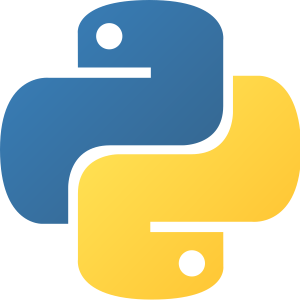 Programming with Python can alleviate the burden of routine, time-consuming tasks for library workers. In this session, attendees will learn how Python is being used at North Carolina State University Libraries to query GOBI and produce automated monthly reports for the Collections & Research Strategy department. GOBI, our print and ebook ordering vendor platform, does not offer an API, so reports used to be compiled through manual title-by-title searching. What used to take up to 15 hours per month (and was the cause of much frustration) now takes just 30 minutes and one press of a “run” button, all thanks to Python’s diverse set of libraries and abilities. Following a presentation of this script and how it was developed, attendees will learn methods for identifying the right Python packages and methodologies for their unique needs and project ideas, even if they are new to programming.
Programming with Python can alleviate the burden of routine, time-consuming tasks for library workers. In this session, attendees will learn how Python is being used at North Carolina State University Libraries to query GOBI and produce automated monthly reports for the Collections & Research Strategy department. GOBI, our print and ebook ordering vendor platform, does not offer an API, so reports used to be compiled through manual title-by-title searching. What used to take up to 15 hours per month (and was the cause of much frustration) now takes just 30 minutes and one press of a “run” button, all thanks to Python’s diverse set of libraries and abilities. Following a presentation of this script and how it was developed, attendees will learn methods for identifying the right Python packages and methodologies for their unique needs and project ideas, even if they are new to programming.
Presenter: Katharine Frazier, University Library Technician, North Carolina State University Libraries.
Upcoming NCompass Live shows:
- July 15 – The Taming of the Site: Helping Users Find What They Need Where They Expect It
- July 22 – Creating Accessible Materials for Library Instruction
- July 29 – Pretty Sweet Tech
For more information, to register for NCompass Live, or to listen to recordings of past events, go to the NCompass Live webpage.
 NCompass Live is broadcast live every Wednesday from 10am – 11am Central Time. Convert to your time zone on the Official U.S. Time website. The show is presented online using the GoToWebinar online meeting service. Before you attend a session, please see the NLC Online Sessions webpage for detailed information about GoToWebinar, including system requirements, firewall permissions, and equipment requirements for computer speakers and microphones.
NCompass Live is broadcast live every Wednesday from 10am – 11am Central Time. Convert to your time zone on the Official U.S. Time website. The show is presented online using the GoToWebinar online meeting service. Before you attend a session, please see the NLC Online Sessions webpage for detailed information about GoToWebinar, including system requirements, firewall permissions, and equipment requirements for computer speakers and microphones.
Free ALA webinar: “Last Chance for a Complete Count”

| ALA is offering a webinar for library staff: 2020 Census: Last Chance for a Complete Count, on July 8 at 2 pm ET. Registration is free. After the session, the recording will be posted at ala.org/census. New guide on adapting census outreach in response to COVID-19: ALA released a new publication, “Libraries and the 2020 Census: Adapting Outreach in Response to COVID-19 (PDF).” The free guide explains changes to the 2020 Census process and highlights opportunities for libraries to adapt census outreach activities. Check your community’s response rate: How does your area compare in its response rate to date? Which neighborhoods are lagging behind? Find current data to inform your outreach and messages on the 2020 Census Response Rate Map or the Census 2020 Hard to Count Map. Share your event on the Census Counts calendar: Is your library planning a 2020 Census event (including virtual events)? Submit it to the national Census Counts calendar. Check the calendar for other events from partners in your community. |
NCompass Live: Identity and Impostor Syndrome in Library Makerspaces
Learn how to master ‘Identity and Impostor Syndrome in Library Makerspaces’ on next week’s FREE NCompass Live webinar, on Wednesday, June 10 at 10:00am CT.
Do makerspaces belong in libraries? Are librarians makers? As makerspaces become more prevalent in libraries, many librarians are questioning their role in the community of tinkerers and creators known as the “Maker Movement.”
Gender imbalance and a lack of diversity in makerspaces can lead to impostor syndrome, or “a false and sometimes crippling belief that one’s successes are the product of luck or fraud rather than skill” (Merriam Webster). Impostor syndrome can affect anyone, but studies suggest that women and people of color are more likely to experience these feelings of inadequacy.
This session will share the findings of one librarian’s examination of her impostor syndrome and consider factors that can contribute to self-doubt in library makerspaces. She will share the results of conversations and interviews with her peers, as well as strategies for managing impostor syndrome. Participants are encouraged to take time to reflect on a time when they felt out of place or unsure of themselves, and share their own approaches for conquering impostor syndrome.
Presenter: Leanne Nay, Digital Engagement Librarian, Indiana University Libraries.
Upcoming NCompass Live shows:
- June 17 – Who are These People & Why are They in My Library? Using Empathy & UX to Understand Your Library Patrons
- June 24 – Pretty Sweet Tech – How to Leverage Online Learning to Build New Skills
For more information, to register for NCompass Live, or to listen to recordings of past events, go to the NCompass Live webpage.
 NCompass Live is broadcast live every Wednesday from 10am – 11am Central Time. Convert to your time zone on the Official U.S. Time website. The show is presented online using the GoToWebinar online meeting service. Before you attend a session, please see the NLC Online Sessions webpage for detailed information about GoToWebinar, including system requirements, firewall permissions, and equipment requirements for computer speakers and microphones.
NCompass Live is broadcast live every Wednesday from 10am – 11am Central Time. Convert to your time zone on the Official U.S. Time website. The show is presented online using the GoToWebinar online meeting service. Before you attend a session, please see the NLC Online Sessions webpage for detailed information about GoToWebinar, including system requirements, firewall permissions, and equipment requirements for computer speakers and microphones.
2020 CARES Act Grants Available from the Nebraska Library Commission
To assist Nebraska public libraries in responding to the coronavirus pandemic, the Nebraska Library Commission has been allocated $165,000 in federal funds to provide grants to libraries through a competitive grant process. These funds are administered by the Institute of Museum and Library Services, from the CARES Act (Coronavirus Aid, Relief, and Economic Security Act, Public Law 116-136). The funding is available to help libraries prepare to reopen to the public and adapt services to reduce the impact of COVID-19.
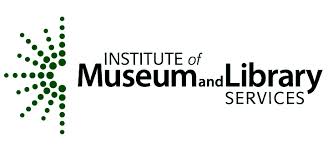
Online applications will be accepted through 11:59 PM (CT) on June 30, 2020 at http://nlc.nebraska.gov/grants/caresact/
All legally established Nebraska public libraries (both accredited and non-accredited) are eligible to apply. Other organizations can partner with an eligible entity for purposes of submitting a grant application for a collaborative project. Partnerships with museums are encouraged. A local match is not required.
The spending principles for these funds are driven by the language in the CARES Act:
- To prevent, prepare for, and respond to COVID-19; and
- To expand digital network access, purchase internet accessible devices, and provide for technical support services.
To achieve these purposes, the funding is to be used as follows:
Primarily to address digital inclusion and related technical support, using the following types of data to inform targeted efforts:
- Poverty/Supplemental Nutrition Assistance Program (SNAP);
- Unemployment; and
- Broadband availability.
Here are some examples of projects that would fit this grant. This list is not exhaustive, but rather intended as a general guide or resource for allowable projects:
Connectivity: Laptops, Chromebooks, tablet computers, or other devices for use inside or outside of the library; hotspots, devices with data plans; Wi-Fi extenders and repeaters; and other equipment upgrades.
Digital content: eBooks; Audiobooks; and databases.
Unemployment related: Online unemployment resources; assistance with job searches; training librarians to assist in unemployment; and partnerships with unemployment related organizations.
COVID-19 response supplies: Disinfectant sprays and wipes; masks; gloves; sneeze guards for desks and counters; and keyboard covers.
Virtual programming: Summer reading and other programs to reach at-risk, educational, or other targeted populations (partnering with museums and tribes, if possible).
**NOTE: Construction projects are not allowable. This includes broadband infrastructure projects that require construction equipment, trenching, construction related trades, and “last mile” projects.
Posted in Grants, Technology, Youth Services
Leave a comment
NCompass Live: Automating Virtual Student Library Cards
Learn about ‘Automating Virtual Student Library Cards’ on next week’s FREE NCompass Live webinar, on Wednesday, June 3 at 10:00am CT.
This session will describe how Scott County Library and Shakopee Public Schools collaborated to automate virtual student library card creation in Shakopee, MN. Participants will learn how to:
- Plan, partner, and collaborate with project stakeholders, including the Library, school district administrators, and technology departments.
- Deploy technical process for automating student library card creation in a SirsiDynix Symphony system. Code discussed is open source and freely available on GitHub.
- Educate the school community about how to use this new resource.
Presenters: Kristy Rieger, Library Technology Manager, Scott County (MN) Library; Sandra Reishus, 6-12 Media Specialist / Innovation Hub Coordinator, Shakopee (MN)Public Schools; Nathaniel Strauss, IT Manager, Shakopee (MN) Public Schools.
Upcoming NCompass Live shows:
- June 10 – Identity and Impostor Syndrome in Library Makerspaces
- June 17 – Who are These People & Why are They in My Library? Using Empathy & UX to Understand Your Library Patrons
- June 24 – Pretty Sweet Tech
For more information, to register for NCompass Live, or to listen to recordings of past events, go to the NCompass Live webpage.
 NCompass Live is broadcast live every Wednesday from 10am – 11am Central Time. Convert to your time zone on the Official U.S. Time website. The show is presented online using the GoToWebinar online meeting service. Before you attend a session, please see the NLC Online Sessions webpage for detailed information about GoToWebinar, including system requirements, firewall permissions, and equipment requirements for computer speakers and microphones.
NCompass Live is broadcast live every Wednesday from 10am – 11am Central Time. Convert to your time zone on the Official U.S. Time website. The show is presented online using the GoToWebinar online meeting service. Before you attend a session, please see the NLC Online Sessions webpage for detailed information about GoToWebinar, including system requirements, firewall permissions, and equipment requirements for computer speakers and microphones.
NCompass Live: Pretty Sweet Tech – How to Make Digital Literacy Less Boring
Learn ‘How to Make Digital Literacy Less Boring’ on next week’s Pretty Sweet Tech FREE NCompass Live webinar, on Wednesday, May 27 at 10:00am CT.
 Special monthly episodes of NCompass Live! Join the NLC’s Technology Innovation Librarian, Amanda Sweet, as she guides us through the world of library-related Pretty Sweet Tech.
Special monthly episodes of NCompass Live! Join the NLC’s Technology Innovation Librarian, Amanda Sweet, as she guides us through the world of library-related Pretty Sweet Tech.
How would you describe Digital Literacy to a patron without making it sound dull as dirt? With more people turning to online learning and resources during the current crisis, Digital Literacy skills are more important than ever. Learning things like online privacy and security, how to effectively communicate online, and how to find and evaluate information online are all vital to our success in the world. Yet many patrons just don’t care. It’s boring.
In this session, I will provide some ideas of what has worked in libraries I’ve visited, and ask you what has worked in your library! We won’t cover all the topics in digital literacy, but you will get a general idea of how to convert a dry digital literacy category into an entertaining learning event! Instead of advertising a “How to Communicate Online” event, call it “What Are You Trying to Say?”
Don’t bring people together over privacy and security. Connect people through a shared desire to stay safe in the wilds of the inter-webs. Make it a game that parents can play with their kids. You are caught in the inter-webs! Avoid the digital obstacles to get you and your kids out safely. Make sure to end the session with a splashy handout they will want to stick on the fridge.
These are just a few of the tantalizing ideas you will encounter in this session. If you want to learn more, check out my Digital Literacy Guidebook. More resources and ideas are being added daily this month. If you’re in Nebraska, the course to Build a Digital Literacy Plan starts on May 25th.
Upcoming NCompass Live shows:
- June 3 – Automating Virtual Student Library Cards
- June 10 – Identity and Impostor Syndrome in Library Makerspaces
- June 17 – Who are These People & Why are They in My Library? Using Empathy & UX to Understand Your Library Patrons
For more information, to register for NCompass Live, or to listen to recordings of past events, go to the NCompass Live webpage.
 NCompass Live is broadcast live every Wednesday from 10am – 11am Central Time. Convert to your time zone on the Official U.S. Time website. The show is presented online using the GoToWebinar online meeting service. Before you attend a session, please see the NLC Online Sessions webpage for detailed information about GoToWebinar, including system requirements, firewall permissions, and equipment requirements for computer speakers and microphones.
NCompass Live is broadcast live every Wednesday from 10am – 11am Central Time. Convert to your time zone on the Official U.S. Time website. The show is presented online using the GoToWebinar online meeting service. Before you attend a session, please see the NLC Online Sessions webpage for detailed information about GoToWebinar, including system requirements, firewall permissions, and equipment requirements for computer speakers and microphones.
Posted in Education & Training, Pretty Sweet Tech, Technology
Tagged NCompLive, prettysweettech
Leave a comment
Four Ways New Technology Is Revolutionizing the 2020 Census

From scribbled answers in 1790 to online responses in 2020, innovation has always been part of the Census. The Census Bureau has always been a leader in using, adapting and developing new technologies, but the 2020 Census will be the most sophisticated and high tech yet.
The census began in 1790 with collected information handwritten by U.S. Marshals visiting outposts in every corner of the new nation. Every decade since, the ways the U.S. Census Bureau has tried to meet its goal of counting every person living in the United States have undergone changes as dramatic as the growth of the nation itself.
Through the centuries, the decennial count progressed from in-person collections of handwritten answers to mass mailings of paper questionnaires in 1970. Among other changes along the way: creation of an electrical punch card tabulator for the 1890 Census and the first use by a government agency of the world’s first modern computer – the UNIVAC 1 – for the 1950 Census. It was developed by engineers John W. Mauchly and J. Presper Eckert, whose corporation was a division of Remington Rand.
In the previous century, Herman Hollerith, a former Census Office employee, invented a punch card tabulating machine used by the Census Bureau from the 1890 Census forward. Hollerith founded the Tabulating Machine Company, which eventually became International Business Machines (IBM).
America Counts spoke with Robert Colosi, a mathematical statistician in the Census Bureau’s Decennial Statistics Studies Division, about ways technology is revolutionizing the census.
He shared four specific changes that have had a major impact on how the Census Bureau counts everyone once, only once, and in the right place.
Innovation 1: Using Satellite Imagery to Check Addresses
Before the Census Bureau can count every person in the country, it must first collect addresses for every housing unit. One way the Census Bureau uses this address list is to mail census materials, including invitations to respond online, by phone or by mail.
Census Bureau employees used to “canvass” neighborhoods in person, jotting down new addresses and correcting old ones on paper.
This long-running operation, known as Address Canvassing, is one of the ways the Census Bureau updates its Master Address File or MAF. The Census Bureau also works with the United States Postal Service (USPS) to confirm already existing addresses on file.
Address canvassing was costly and time-consuming. Employees traveled a total of 137 million miles to update the MAF before the 2010 Census.
“The number of miles we traveled was astronomical,” Colosi said. “We’re not going to do that for the 2020 Census.”
In 2015, the Census Bureau began using aerial images from a network of satellites.
The Census Bureau developed computer software that allows employees in offices to compare satellite images from 2010 to new ones taken in real time. This helps them identify new houses, apartment buildings and other units to verify in the traditional Address Canvassing operation.
Thanks to the new In-Office Address Canvassing system, census workers reviewed 100% of all addresses in the United States for the 2020 Census and validated 65% in the office, removing them from the in-field workload.
That means workers needed to canvas fewer neighborhoods in person, saving time and money.
Address listers or canvassers hit the streets in August 2019 and completed the operation two months later, on track for the 2020 Census.
Innovation 2: Introducing Online Self-Response
The 2020 Census is the first time everyone has the option to respond to the census online as well as by phone or mail.
The Census Bureau has an Internet Self-Response tool designed to make it easy to complete the questionnaire online and keep responses secure. Directions for responding online will be included in letters, postcards and other mailings sent to most homes beginning in mid-March.
Every response submitted on the internet is encrypted. That means data are changed into a code that only Census Bureau data analysts can read. Responses travel through a secure cloud computer network and the Census Bureau locks them in a “digital vault”.
The Internet Self-Response instrument, the website for completing the census online, is available in English and 12 other languages.
Census Bureau employees, called census response representatives will also provide computers and tablets for access to the Internet Self-Response tool at places like libraries, community centers, health care centers and places of worship. This is particularly helpful in rural and other areas with limited or no internet access.
Innovation 3: Introducing Mobile Devices to Enumeration
From collecting census responses and job applications to storing questionnaires, the Census Bureau has used millions of pieces of paper to gather and file information. Now it relies much more on technology – and much less on paper.
In 2020, census takers who go door-to-door to help people respond will collect information on smartphones using a custom application created by the Census Bureau.
“The Systems Engineering and Integration Team created 52 systems in our ‘system of systems,’” Colosi said. “There’s a whole group of systems related to that one contract of enumeration and operations control. All of it was built by Census Bureau staff and contractors.”
To protect privacy, we encrypt all data and devices require two-factor authentication to be unlocked.
When a device connects to the internet, encrypted data immediately transmits to the Census Bureau’s digital vault – and is no longer on the device. Encrypted data are only stored on the devices until they connect to the internet.
Software in the smartphones also provides specific routes for census takers to follow to visit homes. Optimizing routes in this way helps census takers do their jobs more efficiently.
If a device is lost or stolen, the Census Bureau will remotely wipe it clean of all applications and information.
Innovation 4: New Ways to Protect Data
The Census Bureau is the leading source of quality data about the nation’s people and economy in its many surveys and programs, including the 2020 Census.
Opportunities to share and protect its data continue to grow with technology and innovation, particularly through data mashups.
Data mashups are algorithms that combine different data sources to expand graphical understanding of the data but can also find the origin of a particular set of data.
To protect against that, the Census Bureau has developed processes to protect its data from people who might try to make such mashups. Its Disclosure Avoidance System helps prevent improper disclosure of data. This addition is one of several advances the Census Bureau has made to safeguard an individual’s data.
“When we produced products in the old days, we didn’t have super high-tech and savvy users,” Colosi said. “The idea of computing data mashups to try and combine different data sources to find individual responses was not common. Now it is.”
All responses to the 2020 Census are confidential and protected by law. Title 13 of the Federal Code prohibits the Census Bureau from publishing or disclosing any private information, including names, addresses and telephone numbers.
“Our cybersecurity meets the latest, highest standards for protecting your information,” Census Bureau Chief Information Officer Kevin Smith said. “We work with industry experts to continually review and refine our approach to make sure we are staying ahead of threats and ensuring quick response. From the moment we collect your responses, our goal — and legal obligation — is to keep them safe.”
Census Bureau employees take an oath to keep your answers confidential. Violators face up to five years in prison and $250,000 in fines.
Posted in Books & Reading, Census, Education & Training, General, Information Resources, Technology, What's Up Doc / Govdocs
Tagged census
Leave a comment
Census Bureau Launches COVID-19 Data Hub
  The U.S. Census Bureau has released a new resource page on Census.gov to help federal The U.S. Census Bureau has released a new resource page on Census.gov to help federal agencies, businesses, and communities make decisions related to the COVID-19 pandemic. Similar to the Census Bureau’s resources pages created during natural disasters, this resource page includes information on population demographics, economic indicators and businesses. Learn More It features a new interactive data hub that centralizes already-released data from the American Community Survey and the County Business Patterns program to facilitate users’ access to data useful in pandemic-related decision making. The data hub, released as a beta version, will be updated periodically as the situation changes and as feedback is received from users.  You can sign up for COVID-19 Data Hub Updates here. You can sign up for COVID-19 Data Hub Updates here.  |
Posted in Books & Reading, Census, Education & Training, General, Information Resources, Technology, What's Up Doc / Govdocs
Tagged census
Leave a comment
Pretty Sweet Tech: Building Media Literacy

PEN America and the EveryLibrary Institute are offering a Train the Trainer workshop to help librarians teach media literacy on May 27 and May 28 at 1pm Central. The toolkit they offer is versatile, however these resources are especially important as COVID-19 misinformation runs rampant, potentially endangering our communities.
As technology grows more complicated, so do the scams. In a world of social distancing, we are all becoming more reliant on technology to communicate, make purchases, and more. This workshop is about finding information online in a world filled with misinformation.
I just registered for the workshop myself. It is free and runs through Zoom. Before the workshop, take a sneak peek at Pen America’s Guide on COVID-19 and Disinformation.
Some of these tips are tried and true, others are borrowed, or might make us feel blue. But the information is necessary, helpful and timeless. Give it a try, you might learn something new!
If you want to see what the Nebraska Library Commission is doing to help build digital skills, check out my new Digital Literacy Guidebook.
Results From COVID/Cares Act Survey
 As of this week, we have received 163 responses to the COVID/Cares Act survey sent to libraries, representing a 65% response rate. The input of libraries has been valuable to NLC planning for Cares Act funding. Stay tuned for more information about that, but for now, it might be helpful to summarize the survey results.
As of this week, we have received 163 responses to the COVID/Cares Act survey sent to libraries, representing a 65% response rate. The input of libraries has been valuable to NLC planning for Cares Act funding. Stay tuned for more information about that, but for now, it might be helpful to summarize the survey results.
The survey asked what libraries are doing to prepare for re-opening, and what the concerns are upon re-opening. This bar chart at the top illustrates the results, and note that libraries could choose more than one response. Cleaning, handling of materials, and programming topped the list. However, it is important to note that many libraries are concerned about the proximity of patrons in various areas of the library (e.g. meeting rooms, computer labs, etc.). Some noted a potential shift when re-opening to provide extended computer lab hours in order to accommodate needs, or providing more mobile devices for check out (inside or outside of the library) in order to provide social distance.
As far as staffing goes, we know that some libraries have experienced RIF’s (reduction in force), and layoffs, but this has not been the norm. Over 30% of respondents reported all staff reporting to work, and over 30% reported at least the director reporting to work. It is appropriate to note that many libraries only have one primary staff person (the director). Only 6% reported that no staff were coming to work. Numerous libraries are offering alternative services, as over 75% reported providing curbside circulations and over 40% reported providing virtual programming. 90% of survey respondents reported completing tasks associated with circulation and mail processing. This likely includes cleaning and quarantining items, and almost 75% reported maintenance, security, and cleaning tasks performed by staff.
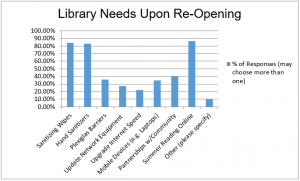 The survey also asked about what the library’s needs are upon re-opening. Topping the list is an alternative to in-person summer reading events, and making sure items are clean and safe by providing adequate sanitizing and protective equipment. This chart at the right shows those results.
The survey also asked about what the library’s needs are upon re-opening. Topping the list is an alternative to in-person summer reading events, and making sure items are clean and safe by providing adequate sanitizing and protective equipment. This chart at the right shows those results.
Finally, some of the open-ended answers give insight into longer-term needs of libraries to address community concerns and prepare for the future. Anecdotally, some of these responses include the following:
- Expanding the range of Wi-Fi to areas outside of the library, allowing for users to be more spread out;
- Device lending to community members that do not have their own (e.g. laptop, tablet computers);
- Providing relevant information about COVID-19 to the community;
- Online/virtual programming;
- eBook and Audiobook availability and access;
- Providing materials (clean and sanitized) such as books, puzzles, music, videos, games, and activity packs to quarantined or at risk groups;
- Improve internet speed and infrastructure to handle increased demands;
- Printing, copy, and fax services (providing with lower touch);
- Reference and partnerships with organizations to support unemployment, economic recovery, small business, and other assistance; and
- Hotspot lending.
Many libraries are now evaluating their technology, network infrastructure, and Wi-Fi (range, speed, etc.). Did you know that NLC offers FREE technology assessments and help to you? If you are interested, please check out our Better Broadband webpage for resources, and to move forward towards an assessment, contact ,Holly Woldt.
Posted in General, Library Management, Public Relations, Technology
Leave a comment
Over $3.5 Million in E-rate Funding Awarded to Nebraska Schools and Libraries
 On May 9, USAC released the first Wave of Funding Commitment Decision Letters (FCDLs) for E-rate Funding Year 2020. Wave 1 includes $3,573,213.39 in funding commitments for 229 Nebraska school and library applicants.
On May 9, USAC released the first Wave of Funding Commitment Decision Letters (FCDLs) for E-rate Funding Year 2020. Wave 1 includes $3,573,213.39 in funding commitments for 229 Nebraska school and library applicants.
Congratulations to all Nebraska schools and libraries who have been funded! A list of libraries who have received E-rate funding is on the NLC E-rate webpage. The 2020 list will be updated as new funding waves are announced.
When your library’s FCDL is ready, it will be attached as a printable PDF to the email notifying you that your FCDL has been issued. It will also be available in the Notifications section of your EPC account, but you are no longer required to log into your EPC account to view it.
As soon as you receive your FCDL, you can go on to the next step in the E-rate process, filing your Form 486. This form is submitted in your EPC account. Information and instructions on how to do that can be found on the USAC website.
If you haven’t received your FCDL yet, don’t panic! There are many more weekly Waves to come as USAC processes more applications. This is just the start of Funding Year 2020, more approvals are coming.
If you have any questions or need any assistance with your E-rate forms, visit the NLC E-rate webpage or contact Christa Porter, 800-307-2665, 402-471-3107.
Pretty Sweet Tech: New Digital Literacy Course
For those who are adding or revamping new digital literacy offerings in your library, the Nebraska Library Commission is offering a comprehensive course to Build a Digital Literacy Plan for your library!
There is no one way to implement digital skills. However, we can explore what our community needs, and how the library can help through a combination of developing programs in-house, working with local and national organizations to meet each community’s growing digital needs. By the end of this course, you will:
- Define digital literacy in your own words, with practical examples.
- Identify a target audience to narrow focus and seek the best sources to meet tangible needs.
- Explore a variety of digital literacy categories to determine what works best for you and your community.
- Use planning worksheets and guides to build a digital literacy plan and prioritize what and how to deal with important items.
Along the way, we will share ideas and compare notes of what worked for others in the state. If you would like to register for this course, please go to http://nlc.nebraska.gov/scripts/calendar/eventshow.asp?ProgId=19463. I’m teaching the course, so I hope to “see” you there.
Posted in Education & Training, General, Pretty Sweet Tech, Technology
Tagged digital literacy, prettysweettech
Leave a comment
The 2020 Census is Still Going Strong!
2020 Census Infogram
Posted in Census, Education & Training, General, Information Resources, Technology, What's Up Doc / Govdocs
Tagged census
Leave a comment
OverDrive Data
For today, we are looking at some data as it relates to libraries offering alternative services during the COVID-19 crisis. Specifically, we are looking at a potential shift to electronic resources, in this case, OverDrive. But first, I want to provide a link to the fantastic data that is being put out by the Nebraska Department of Labor. From the DOL main page, I was looking mostly under their resources, then INFOLink pages, for raw data about unemployment statistics and claims. Next, I found their visualizations, which are excellent, and detail unemployment claims by county with maps, and some very illustrative charts. If you have a chance, visit their visualizations HERE.
Now, to OverDrive. From my colleague here at NLC, I got some data about new OverDrive users, and OverDrive circulations. I was curious to see if there was a correlation between new users and circulations as many libraries shut down operations or offered modified services, such as curbside pickups. The first graphic illustrates libraries with new OverDrive users, and the total number of new users, for the weeks beginning in January, 2020:
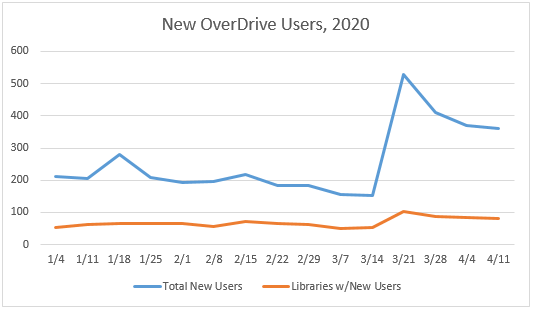
As the chart illustrates, there was a spike during the week of March 14 – 21, then a leveling off. Next, I looked at OverDrive circulations, and you guessed it, they increased:
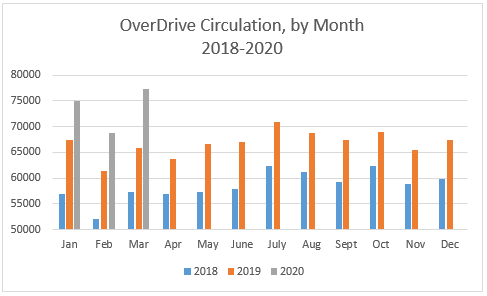
But wait. There’s more to this chart. For this one, I visualized the data from the previous 2 years, 2018 and 2019. If we look at March, we see the large spike in OverDrive circulations from 2019 to 2020, but it helps to put this in perspective. Between March, 2018 and March, 2019, circulations increased at a rate of 15.07%. From March, 2019 to March, 2020, circulations increased at a rate of 17.33%. So a slightly higher percentage of circulation growth compared to the prior year. For February, the 18-19 increase (17.98%) was higher than the 19-20 increase (12.15%). April data might be the telling point to look at, and I intend to post about that when it becomes available.
2020 Census Operational Adjustments
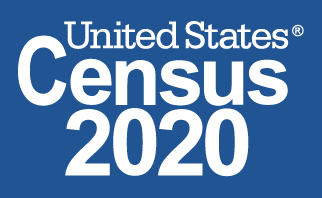
The 2020 Census is underway and more households across America are responding every day. Over 70 million households have responded to date, representing over 48% of all households in America. In light of the COVID-19 outbreak, the U.S. Census Bureau is adjusting 2020 Census operations in order to:
• Protect the health and safety of the American public and Census Bureau employees.
• Implement guidance from federal, state and local authorities.
• Ensure a complete and accurate count of all communities.
The Census Bureau temporarily suspended 2020 Census field data collection activities in March. Steps are already being taken to reactivate field offices beginning June 1, 2020, in preparation for the resumption of field data collection operations as quickly as possible following June 1.
In-person activities, including all interaction with the public, enumeration, office work and processing activities, will incorporate the most current guidance to promote the health and safety of staff and the public. This will include recommended personal protective equipment (PPE) and social distancing practices.
Once 2020 Census data collection is complete, the Census Bureau begins a lengthy, thorough and scientifically rigorous process to produce the apportionment counts, redistricting information and other statistical data products that help guide hundreds of billions of dollars in public and private sector spending per year.
In order to ensure the completeness and accuracy of the 2020 Census, the Census Bureau is seeking statutory relief from Congress of 120 additional calendar days to deliver final apportionment counts.
Under this plan, the Census Bureau would extend the window for field data collection and self-response to October 31, 2020, which will allow for apportionment counts to be delivered to the President by April 30, 2021, and redistricting data to be delivered to the states no later than July 31, 2021.
Posted in Census, Education & Training, General, Information Resources, Technology, What's Up Doc / Govdocs
Tagged census
Leave a comment
American Democracy Project–Video Contest to Promote the 2020 Census
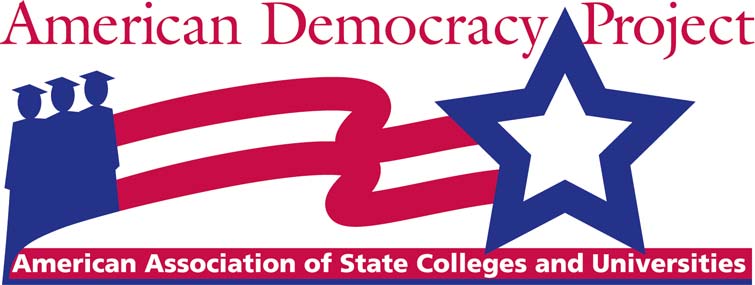
When: April 08, 2020 – April 24, 2020
Time:01:00 PM – 05:00 PM:
The American Democracy Project is sponsoring a video contest to promote awareness for the U.S. Census! Prizes will be awarded to 1st, 2nd, and 3rd place entries; all videos will be judged on accuracy, creativity, and use of visuals/sound. All entries should be submitted to adp@unk.edu by April 24, 2020.
For more instructions, visit https://docs.google.com/document/d/1z3uFwe4jtJgN25Ju2CAE-ovybZ-8UdMIvMFmfEtXrU8/edit?usp=sharing.
Good luck!
Contact:Lydia Behnk
(402) 843-6801
behnkll@lopers.unk.edu
Posted in Census, Education & Training, General, Information Resources, Programming, Technology, What's Up Doc / Govdocs
Tagged census
Leave a comment
Pretty Sweet Tech: 3D Printing Personal Protective Equipment
In this time of crisis, we are all looking for ways to help the healthcare industry do their job safely and effectively. Many homemade face masks, face shields, ventilators, and more have been cropping up. How do we help in the safest way possible?
How to Help
If your library wants to help, I recommend taking a look at the Center for Disease Control (CDC)’s FAQs on 3D Printing of Medical Devices, Accessories, Components, and Parts During the COVID-19 Pandemic. Here are some highlights:
- Most 3D-printed masks are generally not certified or tested as N95 compliant. This should be noted for recipients.
- The mask may look like a normal mask, but a 3D printed mask may not provide the same level of barrier protection, fluid resistance, filtration and infection control.
- The CDC is working with approved organizations to establish better 3D printing guidelines for those who would like to help the cause.
- Make sure you practice quality control and sanitize your environment, according to these guidelines.
For designs that have been reviewed for clinical use through a partner of the CDC, visit the National Institutes of Health 3D Print Exchange. Please note that each design has a recommended material type.
Points of Note for Makers:
- PLA filament, the 3D printer filament commonly found in most library printers, is not currently recommended for printing face masks.
- The best way to help, using PLA, is by printing clinically reviewed Face Shields, or ear comfort guards.
- Make sure you read other maker’s comments and test the durability of your designs yourself before sending them to healthcare workers.
- Follow these instructions to disinfect your work environment and follow quality control. There is no need to transfer disease through the shield that is supposed to stop the spread of disease!
- Make sure the printer is not open to the public. Public libraries can be germ factories!
If you or a local organization has been building your own 3D printed design, please consider submitting your design to be FDA approved and tested. This is the CDC recommended way to safely be part of the solution. As always, I hope this post finds you healthy and well in these unusual times.
Friday Reads: The Other Family, by Loretta Nyhan

“With a dissolving marriage, strained finances, and her life in flux, Ally Anderson longs for normal. Her greatest concerns, though, are the health problems of her young daughter, Kylie. Symptoms point to a compromised immune system, but every doctor they’ve seen has a different theory. Then comes hope for some clarity.
It’s possible that Kylie’s illness is genetic, but Ally is adopted. A DNA test opens up an entirely new path. And where it leads is a surprise: to an aunt Ally never knew existed. She’s a little wild, very welcoming, and ready to share more of the family history than Ally ever imagined.
Coping with a skeptical soon-to-be-ex husband, weathering the resistance of her adoptive mother, and getting maddeningly close to the healing Kylie needs, Ally is determined to regain control of her life. This is her chance to embrace uncertainty and the beauty of family – both the one she was born into and the one she chose.” (Audible)
This book caught my eye because I too was adopted, and as usual, I read and listened to it. I was caught up immediately in the story, and while there are some minor problems with the editing of the audio version, it still held my attention from start to finish.
There are many different ways, and reasons why, adoptees search for their biological families. In Ally’s case, she is desperately looking for answers to explain her daughter’s life-threatening allergic reactions. Ally is so desperate in fact, that she turns to an alternative approach: meditation and desensitization therapy. Through all of the anxiety and uncertainty regarding Kylie’s new treatment, Ally finds not only her “other family,” but her inner strength. That strength helps her resolve issues with her ex, her mom, and her ability to move forward with her life.
Definitely a good read!

